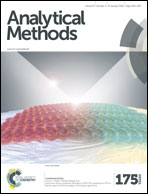Electrochemical behavior and simultaneous determination of catechol, resorcinol, and hydroquinone using thermally reduced carbon nano-fragment modified glassy carbon electrode†
Abstract
The electrochemical behaviors and simultaneous determination of three dihydroxybenzene isomers, i.e., catechol (CC), resorcinol (RC), and hydroquinone (HQ), are studied using a thermally reduced carbon nano-fragment modified glassy carbon electrode (CNF/GCE). The soluble CNF modifier with unique micro-/nano-structure and abundant edges and defective sites is prepared by chemically oxidizing graphite powders, ultrasonically crushing, and thermally reducing treatment in turn. It is shown that the oxidation peak currents of CC, RC, and HQ at the CNF/GCE are improved about 1.74, 2.88, and 1.05 times compared to that of the GCE. The diffusion process in bulk solution controls the electrochemical reaction of CC, RC, and HQ, and their reversible electrochemical process involves equal numbers of protons and electrons. Based on the enhanced electrocatalytic activity and enlarged separation of the anodic peak potential towards three dihydroxybenzene isomers at the CNF/GCE, the simultaneous differential pulse voltammetry (DPV) determination of CC, RC, and HQ, with detection limits (S/N = 3) of 5.0 × 10−7 mol L−1, 8.0 × 10−7 mol L−1 and 4.0 × 10−7 mol L−1, respectively, are obtained. The CNF/GCE also indicates high selectivity, stability, and reproducibility, and is comparable with results of high-performance liquid chromatography in real samples, clearly indicating its applicability.


 Please wait while we load your content...
Please wait while we load your content...